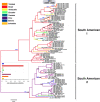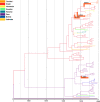Yellow fever virus maintenance in Trinidad and its dispersal throughout the Americas
- PMID: 20631128
- PMCID: PMC2937779
- DOI: 10.1128/JVI.00588-10
Yellow fever virus maintenance in Trinidad and its dispersal throughout the Americas
Abstract
Trinidad, like many other American regions, experiences repeated epizootics of yellow fever virus (YFV). However, it is unclear whether these result from in situ evolution (enzootic maintenance) or regular reintroduction of YFV from the South American mainland. To discriminate between these hypotheses, we carried out a Bayesian phylogeographic analysis of over 100 prM/E gene sequences sampled from 8 South American countries. These included newly sequenced isolates from the recent 2008-2009 Trinidad epizootic and isolates derived from mainland countries within the last decade. The results indicate that the most recent common ancestor of the 2008-2009 epizootic existed in Trinidad 4.2 years prior to 2009 (95% highest probability density [HPD], 0.5 to 9.0 years). Our data also suggest a Trinidad origin for the progenitor of the 1995 Trinidad epizootic and support in situ evolution of YFV between the 1979 and 1988-1989 Trinidad epizootics. Using the same phylogeographic approach, we also inferred the historical spread of YFV in the Americas. The results suggest a Brazilian origin for YFV in the Americas and an overall dispersal rate of 182 km/year (95% HPD, 52 to 462 km/year), with Brazil as the major source population for surrounding countries. There is also strong statistical support for epidemiological links between four Brazilian regions and other countries. In contrast, while there were well-supported epidemiological links within Peru, the only statistically supported external link was a relatively weak link with neighboring Bolivia. Lastly, we performed a complete analysis of the genome of a newly sequenced Trinidad 2009 isolate, the first complete genome for a genotype I YFV isolate.
Figures




References
-
- Aitken, T. H., R. B. Tesh, B. J. Beaty, and L. Rosen. 1979. Transovarial transmission of yellow fever virus by mosquitoes (Aedes aegypti). Am. J. Trop. Med. Hyg. 28:119-121. - PubMed
-
- Beaty, B. J., R. B. Tesh, and T. H. Aitken. 1980. Transovarial transmission of yellow fever virus in Stegomyia mosquitoes. Am. J. Trop. Med. Hyg. 29:125-132. - PubMed
Publication types
MeSH terms
Substances
Associated data
- Actions
- Actions
- Actions
- Actions
- Actions
- Actions
- Actions
- Actions
- Actions
- Actions
- Actions
- Actions
- Actions
Grants and funding
LinkOut - more resources
Full Text Sources

